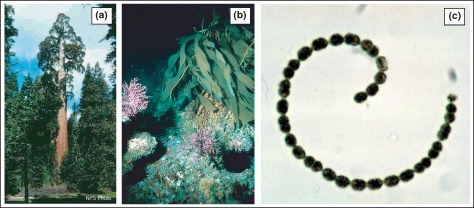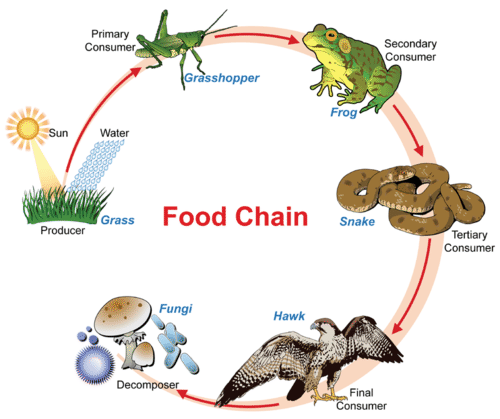6.2 自主营养与血化营养 -- -- 先进
章节大纲
-
What's one major difference between a plant and an animal?
::植物和动物有什么区别?There are many differences, but in terms of energy , it all starts with sunlight. Plants absorb the energy from the sun and turn it into food . You can sit in the sun for hours and hours. You will feel warm, but you're not going to absorb any energy. You have to eat to obtain your energy. You, of course, can go to the kitchen and cook something to eat. Other can also eat, but a plant cannot.
::有很多差异, 但从能量方面来说, 这一切都从阳光开始。 植物吸收太阳的能量, 把它变成食物。 你可以坐在太阳里坐上几个小时, 你会感到温暖, 但你不会吸收任何能量。 你必须吃东西才能得到能量。 当然, 你可以去厨房做饭吃东西。 其他人也可以吃, 但植物不能吃。How Do Organisms Get Energy? Autotrophs vs. Heterotrophs
::生物体如何获得能源?Living organisms obtain chemical energy in one of two ways.
::活生物体以两种方式之一获得化学能量。Autotrophs , shown in the Figure , store chemical energy in food molecules they produce themselves. Food is chemical energy stored in organic molecules . Food provides both the energy to do work and the carbon to build the organic structures from to organisms. Because most autotrophs transform sunlight to make or synthesize food, we call the process they use . The food produced via this process is glucose . Only three groups of organisms - plants, , and some - are capable of this life-giving energy transformation. Autotrophs make food for their own use, but they make enough to support other life as well. Almost all other organisms depend absolutely on these three groups for the food they produce. The , as autotrophs are also known, begin that feed all life. Food chains will be discussed in the Ecology concepts.
::食品是有机分子中储存的化学能量。 食品既提供工作能量,也提供碳,从有机体中建立有机结构。由于大多数自发性能改变阳光,制造或合成食物,我们称之为它们使用的过程。通过这个过程生产的食品是葡萄糖。只有三组有机体——植物,和某些生物——能够进行这种给生命的能量转换。自发性能使食物供自己使用,但它们也足以养活其他生命。几乎所有其它生物都完全依赖这三类生物来生产食物。正如人们所知道的那样,自发性食物也开始养活所有生命。在生态概念中将讨论食物链。Photosynthetic autotrophs, which make food for more than 99% of the organisms on earth, include only three groups of organisms: plants such as the redwood tree (a), algae such as kelp (b), and certain bacteria like this Anabaena (c). Heterotrophs cannot make their own food, so they must eat or absorb it. For this reason, heterotrophs are also known as consumers . Consumers include all animals and and many and bacteria. They consume either autotrophs or other heterotrophs. Heterotrophs show great diversity and may appear far more fascinating than producers. However heterotrophs are limited by their utter dependence on those autotrophs that originally made the food. If plants, algae, and autotrophic bacteria vanished from Earth, animals, fungi, and other heterotrophs would soon disappear as well. All life requires a constant input of energy. Only autotrophs can transform that ultimate, solar source into the chemical energy in food which powers life, as shown in the Figure .
::食用或吸收食物。 因此, 食用或吸收食物也被称为消费者。 消费者包括所有动物和许多以及细菌。 消费者包括所有动物和许多细菌。 他们消费自发性或其他血化物质。 血化营养表现出极大的多样性,可能比生产者更引人入胜。 但是, 血化营养由于完全依赖最初制造食物的自发性食物而受到限制。 如果植物、藻类和自发性细菌从地球消失, 动物、真菌和其他热养分也很快消失。 所有生命都需要不断的能源投入。 只有自发性能才能将最终的太阳能转化为食物中的化学能源,如图所示。Food chains carry energy from producers (autotrophs) to consumers (heterotrophs). 99% of energy for life comes from the sun via photosynthesis. Note that only nutrients are recycled. Energy must continue to flow into the system. Though this food chain "ends" with decomposers, do decomposers, in fact, digest matter from each level of the food chain? (See the Energy Transfer: Decomposers (Advanced) concept). Photosynthesis provides over 99% of the energy supply for life on Earth. A much smaller group of autotrophs - mostly bacteria in dark or low-oxygen environments - produce food using the chemical energy stored in inorganic molecules such as hydrogen sulfide, ammonia, or methane. While photosynthesis transforms light energy into chemical energy, this alternate method of making food transfers chemical energy from inorganic to organic molecules. It is therefore called and is characteristic of the tubeworms shown in the Figure . Some of the most recently discovered chemosynthetic bacteria inhabit deep ocean hot vents or “black smokers.” There, they use the energy in gases from the Earth's interior to produce food for a variety of unique heterotrophs: giant tube worms, blind shrimp, giant white crabs, and armored snails. Some scientists think that chemosynthesis may support life below the surface of Mars, Jupiter's moon, Europa, and other planets as well. based on chemosynthesis may seem rare and exotic, but they too illustrate the absolute dependence of heterotrophs on autotrophs for food.
::光合作用将光能转化成化学能量,而这种将化学能量从无机分子转移到有机分子的替代方法,因此被称为并且是图中所显示的管虫的特征。最近发现的化学合成细菌中有些位于深海热喷口或“黑烟者 ” 。 在那里,它们利用地球内部气体中的能量生产食物,用于各种独特的热营养:巨型管状虫、盲虾、巨型白蟹和装甲蜗牛。一些科学家认为,化学合成可能支持火星、木星月、欧罗巴和其他行星表面以下的生命。基于化学合成可能看起来很罕见,很奇特,但是它们也太能地说明对食物的绝对依赖性。Tubeworms deep in the Gulf of Mexico get their energy from chemosynthetic bacteria living within their tissues. No digestive systems needed! Phototrophs are organisms that capture light energy and convert it to chemical energy inside their cell. Most phototrophs are the autotrophs that perform photosynthesis, which are also known as photoautotrophs . These organisms have the ability to fix carbon from carbon dioxide into , such as glucose. Chemotrophs , on the other hand, do not get their energy from carbon. These are organisms that break down either organic or inorganic molecules to supply energy for the cell through chemosynthesis. Chemotrophs can be either autotrophic (chemoautotrophs) or heterotrophic (chemoheterotrophs). Chemoautotrophs derive their energy from chemical reactions and synthesize all necessary organic compounds from carbon dioxide. Chemoheterotrophs are unable to fix carbon to form their own organic compounds. The various types of metabolisms are discussed in the : Nutrition and Metabolism (Advanced) concept.
::光养分是捕捉光能并将其转换为细胞内化学能量的有机体。大多数光养分是进行光合作用的自养分,也称为光亚营养体。这些有机体有能力将二氧化碳的碳固定成诸如葡萄糖等。另一方面,化学养分不能从碳中获得能量。这些有机或无机分子通过化学合成为细胞提供能量的有机体或无机分子。化学养分可以是自养(化学养分),也可以是热营养(化学耐养分)或热血营养(化学耐养分)。化学养分从化学反应中获取能量,从二氧化碳中合成所有必要的有机化合物。化学耐养分不能将碳固定成自己的有机化合物。在营养和代谢(预变)概念中讨论了各种类型的新陈代谢。This flowchart helps to determine if a species is an autotroph or a heterotroph, a phototroph, or a chemotroph. For example, “Carbon obtained from elsewhere?” asks if the source of carbon is another organism. If the answer is “yes”, the organism is heterotrophic. If the answer is “no,” the organism is autotrophic. Summary
::摘要-
Food is chemical energy stored in organic molecules.
::食物是储存在有机分子中的化学能量。 -
Food provides both the energy to do life's work and the carbon to build life's bodies.
::食物既能提供生命工作所需的能量,又能提供建立生命身体所需的碳。 -
Autotrophs make their own carbohydrate foods, transforming sunlight in photosynthesis or transferring chemical energy from inorganic molecules in chemosynthesis.
::自发性自给性自给性碳水化合物食品,在光合作用中改变阳光,或将化学能量从化学合成的无机分子中转移出来。 -
Heterotrophs consume organic molecules originally made by autotrophs.
::血红营养素消耗了原由自发性制造的有机分子。 -
All life depends absolutely upon autotrophs to make food molecules.
::所有的生命 都完全依赖自养 来制造食物分子
Review
::回顾-
Water and carbon dioxide molecules are reactants in the process of photosynthesis. Does this mean they are “food” for plants, algae, and blue-green bacteria? Use the definition of “food” to answer this question.
::水和二氧化碳分子在光合作用过程中是反应物。 这是否意味着它们是植物、藻类和蓝绿色细菌的“食物 ” ? 使用“食物”的定义来回答这个问题。 -
Compare autotrophs to heterotrophs, and describe the relationship between these two groups of organisms.
::将自发性比作进化性,描述这两组生物之间的关系。 -
Name and describe the two types of food-making found among autotrophs, and give an example of each. Which is quantitatively more important to life on Earth?
::命名并描述在自养成中发现的两种食品生产类型, 并举一个例子来说明其中两种。 哪种在数量上对地球上的生命更重要? -
Define chemosynthesis.
::定义化学合成。 -
Trace the flow of energy through a typical food chain (describing "what eats what"), including the original source of that energy and its ultimate form after use. Underline each form of energy or energy-storing molecule, and boldface each process that transfers or transforms energy.
::通过典型的食物链(描述“什么吃什么 ” ) 追踪能源流动,包括能源的原始来源及其使用后的最终形式。 以各种能源或能源存储分子为底线,并以粗体显示能量转移或转化过程。
-
Food is chemical energy stored in organic molecules.




